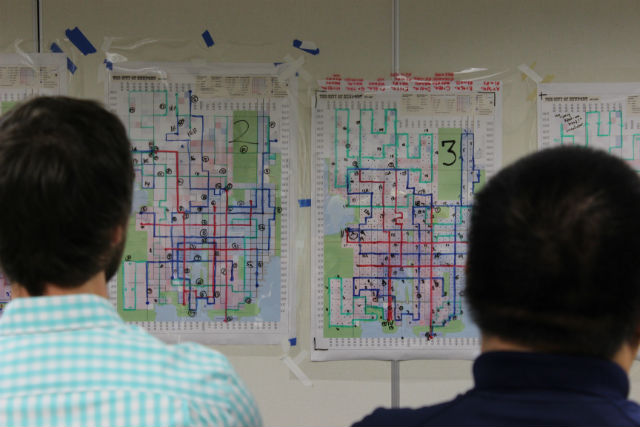The SIMPLE art of transit network design
The SIMPLE art of transit network design

It is a rainy morning at the Vancouver Transit Centre. I’m sitting with a room full of colleagues and five pots of coffee. What do we all have in common? We are all keen to better understand the considerations and strategy behind transit network design…and although we all work for TransLink, none of us are actual transit planners.
As an introduction, our fearless instructor Jarrett Walker performs a soliloquy on ridership, density, frequency and demand. His poetry makes us feel at ease. As he presents us with the network design challenges for the course, we are confident that we can find the solutions. Even without the academic training and years of experience, we are certain that using the tools we’ve only just been taught will be “s-i-m-p-l-e”.
We work in groups to plan multiple transit networks over the two-day course. Our tool kit includes a map and a spreadsheet filled with mathematical equations. Our fictional city map showed land-use patterns, population density, landmarks and major roads and bridges. We have a budget and the spreadsheet helps us keep track of how many buses and at what frequency we can afford.
I realized during the first challenge that I had underestimated the difficulty of the task. I thought I was using common sense to plan an efficient network. I chose a population dense area and identified a number of destinations: the airport, the shopping district, the hospital. I was planning for how a single person could get to each landmark. I assumed that because these were community destinations it would make sense to have frequent service. But I was wrong. When it was time for the trip test – getting a fictional rider from multiple arrival to destination points– all the networks were put to the test.
The network that was most efficient did not focus on single trips; it was designed to connect people from high density areas to as many destinations as possible while maximizing the budget. This was my “Aha!” moment. It was not enough to get the fictional Jane to the airport and hospital, the network had to also get her to the soccer field, her office building and the pet store. Turns out, with finite resources there are mathematical trade-offs and balancing the competing needs to provide access and offer direct and frequent service is not “s-i-m-p-l-e” at all.
The course is over and I’ve put away my design pens. The next time I think “gee, I wish I could take transit to the grocery store, but I have to walk a few blocks and it is slower than taking my car,” I’ll take a minute to remember. I’m going to remember that unless many people in my neighbourhood are traveling to the grocery store, post office and hospital every day, throughout the day, there may not be the ridership demand to justify having a high frequency service to accommodate my whims to take the bus to the grocery store.
Author: Angela Salehi






Nothing about this on the blog???
http://www.translink.ca/en/About-Us/Media/2015/February/TransLink-Board-initiates-search-for-new-CEO-and-appoints-interim-CEO.aspx
Hi Sheba: Yes, we were remiss to blog about that. However, on Wednesday we didn’t have any more info other than what was included in the press release – http://www.translink.ca/en/About-Us/Media/2015/February/TransLink-Board-initiates-search-for-new-CEO-and-appoints-interim-CEO.aspx. I have good news though. We’ve just done an interview with Doug and will put that on the blog early next week!
Well I guess I can forgive you – as long as it doesn’t have to start with “Roses are red…” ;)